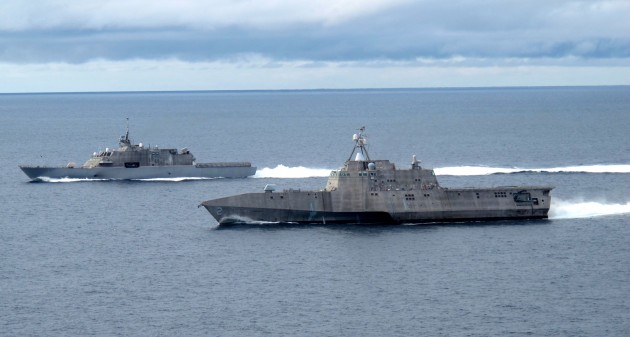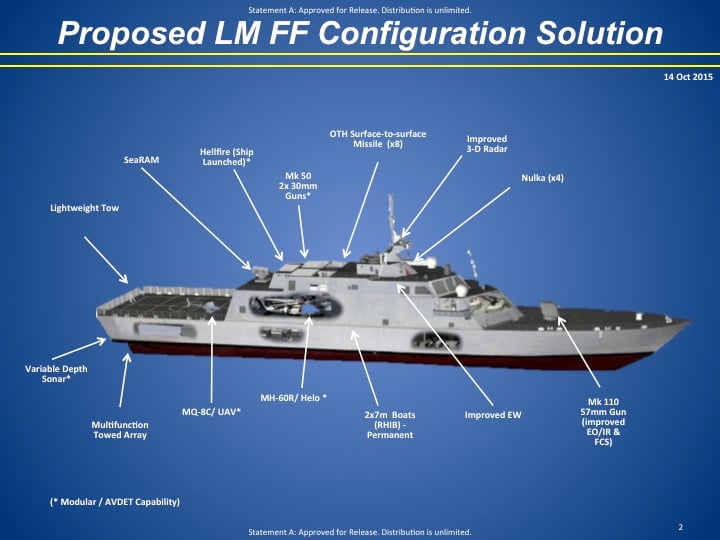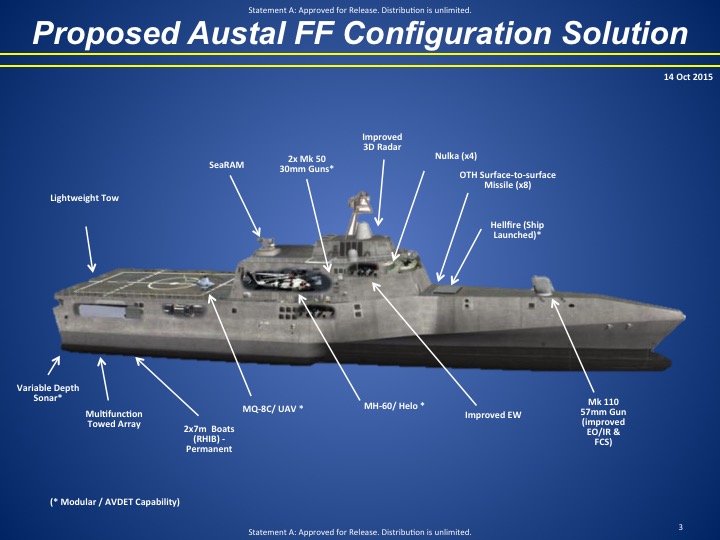Navy Wants LCS ‘Frigate’ Upgrade A Year Earlier: 2018, Not 2019
Posted on

The two Littoral Combat Ship variants, LCS-1 Freedom (far) and LCS-2 Independence (near).
NATIONAL HARBOR: The Navy wants to start building the upgraded “frigate” version of its controversial Littoral Combat Ship a year earlier, the frigate program manager said. The fixed-price, winner-take-all competition will “tentatively” happen in 2018 instead of 2019. To make that earlier date, Capt. Dan Brintzinghoffer said at the Sea-Air-Space conference here, the Navy will be “less prescriptive” in saying how to implement the various features of the upgrade, giving each competitor more leeway as it modifies its current LCS design.
Who are those competitors? Currently, the Navy buys two very different versions of the LCS from two different shipyards: Marinette Marine in Wisconsin — partnered with aerospace giant Lockheed Martin — and Austal on the Gulf Coast. When Defense Secretary Ash Carter decided last year to cut the LCS program from 52 ships to 40, he also ordered the Navy to pick one design and one yard no later than 2019, when production shifted from the original flavor LCS to the upgraded frigate. Now the Navy is shooting for a “downselect” in late 2018, Brintzinghoffer said, with a formal Request For Proposals out late in 2017.

Lockheed Martin variant
What’s the hurry? First of all, to have a healthy competition, you need both competitors to still be building LCS: Otherwise one will have to stop and then restart its production line, driving up its costs and crippling its bid. But the Pentagon’s five-year spending plan (the FYDP) only budgets for one LCS in 2018, Brintzinghoffer explained, and whichever yard got to build it would have a big advantage in a 2019 competition. Moving the decision to 2018 keeps things fair.
Second, while Brintzinghoffer didn’t emphasize this point, starting frigate production a year earlier means the Navy gets more of the upgraded frigate LCS. Conversely, it would get fewer of the original vanilla version, although the Navy plans to backfit at least some of the frigate upgrades on basic LCS. Specifically, the captain said, the number of frigates would go up from eight to 12, a whopping 50 percent increase. (The number of regular LCS would drop from 32 to 28).
Starting earlier is fact the only way to get more frigates. Continuing the production run longer is not allowed because Secretary Carter has capped the total production — original flavor LCS plus frigates, in whatever combination — at 40 ships.
The Navy isn’t thrilled with that figure. “The requirement across the Navy — based on a 2014 Force Structure Analysis — is for 52 small surface combatants,” Brintzinghoffer said, echoing Navy leaders. (That figure is likely to increase in the Navy’s ongoing Force Structure Assessment). The Navy could build the 40 LCS and then 12 of something else, but so far there’s no clear alternative design.
The House Armed Services Committee has voted to add an additional LCS to the administration’s proposed 2017 budget, but its Senate counterparts have not. In fact, the Senate Armed Services Committee draft “prohibits revisions to or deviations from the current LCS acquisition strategy, which includes…a down-select to a single variant no later than 2019, and a reduction in the inventory objective to 40 ships.
So, at least for now, “we’re kind of rolling with the punches with the way the budget flows and the direction that we have receive,” Brintzinghoffer said, “working towards an FY18 downselect to a frigate design.”

Austal variant
So, I asked Brintzinghoffer at his briefing here, what’s the biggest obstacle to moving the competition up a year?
“The biggest thing is we have to come to an agreement with both of the primes…to make sure that the design, the level of design is sufficient and mature enough that they can competitively bid, because we’re going to be asking them for fixed price bids,” Brintzinghoffer said.
“In a competition one of the advantages the government gets is going to be a lower price,” the captain continued, but for the builders to squeeze costs out of their designs, they needed more freedom to make trade-offs. “We needed to give them back some of the trade space,” he said, “so we became less prescriptive in the way the two shipbuilders were going to… deliver a particular functional capability.”
That said, the Navy is very clear on the frigate’s capabilities: a full suite of anti-ship and anti-submarine sensors and weapons, combining two of the three “mission modules” for the existing LCS, plus such improvements as a medium-range “over the horizon” missile to sink enemy ships.
The service also wants to backfit as many of these improvements on the vanilla LCS as possible, with a high priority on that Over The Horizon (OTH) anti-ship missile. Some original flavor LCS may even get redesignated as frigates if they’re upgraded enough, Brintzinghoffer said, although just adding the missile won’t be enough to do it.
Nor is it a simple matter of bolting new gear onto the old design, he warned. It’s much easier to build a big component – say, an OTH missile launcher — into a ship in the first place than it is to add one to a ship already built. A backfitted LCS may well fit fewer OTH missiles than a frigate, for example, or have them in a different place.
When you sit there and say, ‘I want to put something internal to the skin of the ship,’ and it’s big enough that you can’t bring it in through a hatch, it now gets very expensive,” Brintzinghoffer told me after the briefing. Which brings you to “the other piece about forward fit and backfit,” he said: “When you forward-fit something (i.e. build it into a new ship), you’re paying for it with SCN money, Ship Construction, Navy funds. (Upgrades to an existing ship are) using OPN, which is Other Procurement, Navy.” It’s often harder for items to compete for OPN funds than SCN — just one more complication in the long saga of the LCS.
Subscribe to our newsletter
Promotions, new products and sales. Directly to your inbox.
